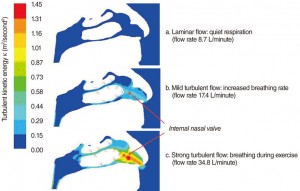Nasal peak flow test is inexpensive, easy to perform, and may have potential use in outpatient clinical trials or for home assessment of daily variations in nasal obstruction; however, it is highly effort dependent, and results may vary widely, especially between patients. This technique involves measuring the peak inspiratory nasal airflow with a modified peak flow device. Although peak flows do not measure resistance, nasal peak flow measurements correlate well with measurements of resistance and have their greatest usefulness in the detection of large changes in nasal patency in individual subjects. 
Since air flows from an area of high pressure to an area of low pressure, pressure gradients and flow measurements may be used to calculate NR. Rhinomanometry, the measurement of nasal airway resistance, is probably the test most frequently performed because it measures both flow and resistance. It is classically divided into passive or active phases, and into anterior or posterior rhino-manometry. Active rhinomanometry requires the subject to generate airflow through the nose by their own effort. Passive rhinomanometry utilizes external generation of a constant flow of air at a given pressure and requires no respiratory effort. Active rhinomanometry is a quick test to perform, and the International Committee on Standardization of Rhi-nomanometry recommends it for most studies Viagra online Australia. Anterior and posterior rhinomanometry primarily differ in the location of the transducer used to measure posterior pharyngeal pressure. Anterior rhi-nomanometry may be affected by deformation of the anterior nares and/or valves, nasal cycling, and by the instrument inserted to the nares for measurement. Posterior rhinomanometry does not have these disadvantages, but is more expensive and requires more patient cooperation, with approximately 15% of subjects being unable to place the probe properly in the oral cavity.
Despite these drawbacks, it is an excellent tool for determining the degree of airflow obstruction before and after surgical procedures and medical interventions. It may also help to distinguish functional causes of upper airway obstruction from structural causes. For example, decongestants or exercise will improve airflow due to inflammation and vascular engorgement, whereas fixed abnormalities such as concha bullosa do not change after exercise or decongestants. Rhino-manometric measurements before and after treatment with a potent intranasal decongestant agent are recommended Cialis Australia.